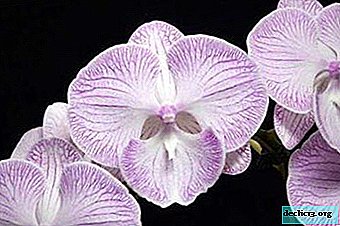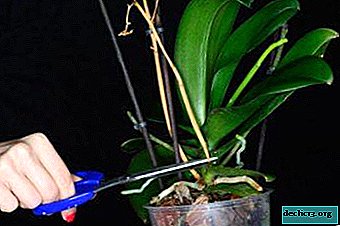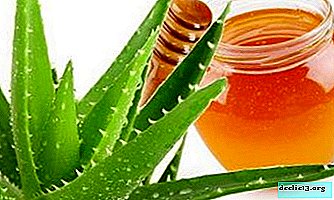Dutch beauty - phalaenopsis Big Lip: photo color options and care secrets

Orchid is one of the most popular plants at the moment. Therefore, breeders are constantly breeding new species to please fans of orchids. Such a novelty can be attributed to Big Lip.
The second name of this beauty is Leontin. This is one of the varieties of phalaenopsis, which appeared not so long ago and was bred in a hybrid way.
From the article you will learn about what this flower looks like, what sub-varieties it has, how to properly care for it.
Botanical description and appearance
So what kind of plant is this? Let's first look at its appearance.
The stalk bowl is slightly shortened. The leaf plates are wide, can reach a length of thirty centimeters. Moreover, they are evergreen. The grown Big Lips usually have five to six leaves. This plant cannot form a wide bush, as it grows exclusively upwards, throwing flower stalks. A feature of any phalaenopsis is the presence of aerial roots.
 The flower buds themselves bloom on peduncles, many open flowers resemble fluttering butterflies. The number of flowers and blooms in general depends entirely on the intricacies of care.
The flower buds themselves bloom on peduncles, many open flowers resemble fluttering butterflies. The number of flowers and blooms in general depends entirely on the intricacies of care.
The roots are green, since they also take part in the process of photosynthesis, which means that chlorophyll is present in them.
Big Lip - a rather rare representative of phalaenopsis. Finding them for sale is extremely difficult. the main characteristic is the petals, which, like other phalaenopsis, resemble moths, but on top of that they have curly edges, while flowers can reach sizes up to twelve centimeters.
Reference! Another distinguishing feature is the large lip size of Leontin's flowers. The color is usually saturated, while it can be the most diverse: from pale yellow to lilac.History of occurrence
This plant was named after the popular Dutch TV presenter Leontin Borsato. First presented Big Lip in the Netherlands. It was relatively recently - in September 2012.
Differences from other orchids
There are no particular differences regarding the internal structure. Often, new varieties are bred in order to dilute the palette of existing colors. Big Lip was no exception. It stands out only with new interesting colors and larger sizes of inflorescences.
Sub-grades and color options
Currently known colors are Leontin:
- Blueberry
- white spotted (with blueberry blotches);
- pale pink;
- lilac (can be with white edges);
- white (without any impurities);
- white with pink spots;
- and even blue (well, a very rare species).
Not all colors have gotten names yet, so sub-grades are usually not named at all, but are focused only on shade.
Photo
Below you can find a photo of the orchid, each image is accompanied by the name of the sub-variety or color.
White spotted

White

Pale pink

Blueberry

Bloom
In the natural habitat begins to bloom after a season of prolonged heavy rains. This usually happens in late autumn (in November). At home, phalaenopsis can dissolve buds at any time., it all depends on the quality of care. Moreover, flowering can occur several times a year (but do not get carried away with this).
Important! The duration of flowering also depends on the created conditions. It can even be six months long.Care before and after
Before the orchid dissolves its most delicate buds, it must be looked after according to the standard algorithm:
- water correctly;
- fertilize;
- humidify the air;
- choose a suitable place.
We will describe all this in detail below. Phalaenopsis requires special attention after flowering, because at this time it is very weakened. After Big Lip drops all the flowers, you must:
- Trim the flower stalk. But take your time to do it. It should dry, and only then can you take on the pruner. Otherwise, the orchid will not regain strength after flowering, since it is the peduncle that preserves all the beneficial substances that the entire plant subsequently nourishes. You need to trim not only on time, but also correctly.
If the peduncle is completely dry, leave two or three centimeters from the root outlet, and remove the rest. If the peduncle is only partially dried, get rid of the dry part without touching the swollen buds. Manipulation is necessary a couple of centimeters above the pseudo kidney.
 To process the place of slices. It is better to do this with ordinary wax from a burning candle. This procedure clogs a sore spot, preventing water from getting there, as well as evaporating water, overdrying the plant.
To process the place of slices. It is better to do this with ordinary wax from a burning candle. This procedure clogs a sore spot, preventing water from getting there, as well as evaporating water, overdrying the plant.- Put the orchid in a dark place for a week and give it a rest. In this case, you do not need to water it and especially fertilize it.
- After "rest", if necessary, transplant the plant.
What if it does not happen?
What needs to be done so that your pet will delight you not only with its greenery, but also with the tenderness of flowers.
- Provide enough light. Do not forget that it must be scattered. No direct sunlight!
- Do not overdo soil moisture. Watering phalaenopsis is necessary only after two to three days have passed, when the topsoil has become dry. You can generally arrange a period of drought for the plant. The fact is that in the tropics during prolonged rains there are no insects that pollinate the flower. Therefore, at home, Big Lip behaves similarly: a lot of water, then blooming is not the time.
- Fertilizers must be correct and metered. For example, if there is too much potassium in the nutrient complex, its green part will develop in the plant. if you want to see as many buds as possible, use nitrogen-phosphorus top dressing.
- Cheer Lenotina. To do this, it is necessary to organize stressful conditions for her. This can lower the temperature, move to a dark place (but do not get carried away by changing the place too often - the orchid does not like this), reducing watering.
Plant content
Choose a place
When choosing a place of residence for her beauty, remember that she loves good lighting and airing. But in no case should airing go into drafts, from which the orchid will immediately begin to hurt.
Advice! Choose southern window sills for placement of flowerpots with flowers. If this does not work out, it should be at least the southeast or southwest sides of the room. But keep in mind that in the northern part of the room the orchid will not take root.Preparing the soil and pot
 Immediately specify the characteristics of the pot. The pot must be transparent and smooth.. This is because the rhizomes take part in the process of photosynthesis, so they need to provide access to light. Also, the roots can grow into the rough surface of the walls of the pots, so they must be smooth.
Immediately specify the characteristics of the pot. The pot must be transparent and smooth.. This is because the rhizomes take part in the process of photosynthesis, so they need to provide access to light. Also, the roots can grow into the rough surface of the walls of the pots, so they must be smooth.
It is better for a novice grower not to experiment with self-preparation of the soil mixture. Better get the finished substrate in the store. This primer should be designed specifically for orchids. Ordinary soil will not work. Those who wish to prepare the mixture themselves will need to take:
- bark;
- charcoal;
- coarse sand;
- moss;
- clay granules;
- fiber of plant origin.
All this mix in equal proportions.
Temperature
The most optimal temperature regime for phalaenopsis in summer is 20-23 degrees above zero. In winter, these indicators can be reduced to 18-20 degrees of heat. The permissible norm for a short time can be +16 degrees.
It is worth noting that the difference in day and night temperature should be at least four degrees, but not more than five degrees. This is a prerequisite for the maintenance of Leontina, as well as other types of phalaenopsis.
Attention! If in the warm season you put a flowerpot with a flower in the open air, the temperature is adjusted by itself.Lighting
In this article, we have already mentioned more than once that Big Lip prefers a lot of light. But this should not be burning sun rays. To protect the plant from them, hang a reflective foil on the window or just a sheet of paper.
Daylight hours should be long: from ten to twelve hours. It is not always possible to maintain this condition naturally, so turn to artificial lighting for help. But make sure that the lamps do not heat up.
Watering
 In this matter, adhere to the golden rule: it is sometimes better to forget to moisten the soil than to do it with an enviable frequency. Notice that the top two or three centimeters have dried up? Wait a couple more days and only then water the plant again. This can be done both by immersion and by shower (at this time, the surface of the flower is also cleansed).
In this matter, adhere to the golden rule: it is sometimes better to forget to moisten the soil than to do it with an enviable frequency. Notice that the top two or three centimeters have dried up? Wait a couple more days and only then water the plant again. This can be done both by immersion and by shower (at this time, the surface of the flower is also cleansed).
Do not neglect the moistening of leaf blades and the air around the orchid. Spray the entire Big Lip often and place a container of water near the pot.
Top dressing
We recommend that you do not really get carried away with dressing orchids. This should be done no more than once every ten days. It is better to use complex fertilizers for feeding. Everything is already balanced in them, taking into account the requirements of the Leontins.
Important! Fertilizing fertilizers is necessary only according to the instructions written on the package.Transfer
Flower growers advise updating the soil every couple of years. It may be necessary to transplant an orchid as the root system grows. But take the pots not much more than the previous ones. Transplanting phalaenopsis is allowed only after the last bud from the peduncle falls.
Next, we suggest watching a video about transplanting this orchid:
How to propagate?
Propagating an orchid Big Lip is very difficult. But we will talk about two methods that are most suitable for carrying out at home.
- By the kids. Sometimes on the peduncles you can notice the lateral processes. They are called kids. To put them in a separate container, wait until the shoots have small roots, then cut them with a sharp blade and put them in a small flowerpot. The places of cuts on the mother-orchid process with crushed charcoal.
- Division of rhizomes. This can only be done in cases where the root system is dense and there are several shoots. Separate the roots so that at least one pseudobulb remains on each part and plant them in pots.
Diseases and Pests
 All diseases are associated exclusively with improper care. Therefore, if you notice yellowing or decay of any parts of the plant, reconsider the care of the orchid. For example, the roots rot only from an excess of moisture, and the leaves turn yellow from a lack of moisture or from strong sunlight. It is necessary to fertilize an orchid, so it will increase its immunity and will be able to fight infections.
All diseases are associated exclusively with improper care. Therefore, if you notice yellowing or decay of any parts of the plant, reconsider the care of the orchid. For example, the roots rot only from an excess of moisture, and the leaves turn yellow from a lack of moisture or from strong sunlight. It is necessary to fertilize an orchid, so it will increase its immunity and will be able to fight infections.
All pests can be destroyed in three ways.:
- Mechanical. Collect all the parasites by hand. But keep in mind that this will not provide one hundred percent disposal of pests.
- Chemical. Insecticides are best suited for this. But they need to be applied at least twice and with a break of 5-7 days.
- Folk remedies. There are a lot of them. The most popular is a soap solution. Some gardeners recommend wiping the leaves with an alcohol solution, but we recommend that you refrain from this. Since alcohol can burn sheet plates during evaporation.
Remember that only a systematic and competent approach will help to cope with diseases and pests.
Prevention of various problems
To avoid any problems with growing Big Lip orchids, just follow all the directions described above. And do not engage in amateur performances and experiments.
Remember that Leontin is a very rare type of orchid.. Therefore, if you have one, treat him with full responsibility so as not to lose this rare beauty.

 To process the place of slices. It is better to do this with ordinary wax from a burning candle. This procedure clogs a sore spot, preventing water from getting there, as well as evaporating water, overdrying the plant.
To process the place of slices. It is better to do this with ordinary wax from a burning candle. This procedure clogs a sore spot, preventing water from getting there, as well as evaporating water, overdrying the plant.















